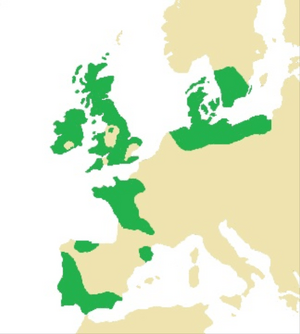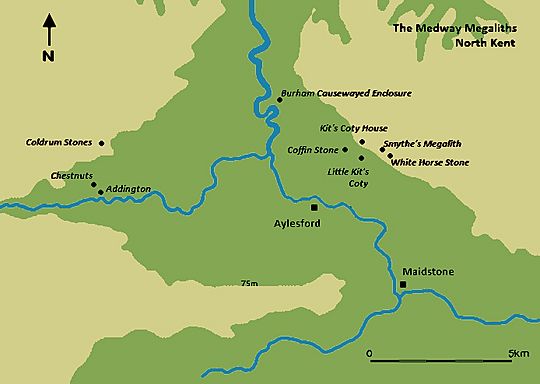Addington Long Barrow facts for kids

View of the damaged burial chamber
|
|
| Lua error in Module:Location_map at line 420: attempt to index field 'wikibase' (a nil value). | |
| Location | Addington, Kent |
|---|---|
| Type | Long barrow |
The Addington Long Barrow is an ancient burial mound located near Addington in Kent, England. It's a type of tomb called a chambered long barrow. It was likely built around 4,000 to 3,800 BCE, during a time called the Early Neolithic period in Britain. Today, it is mostly in ruins.
This large mound was made of earth and about fifty huge stones called sarsen megaliths. It had a rectangular shape with a stone chamber at one end. This chamber was probably where people buried their dead, though no human remains have been found here.
Experts believe that early farming communities built this monument. It's part of a bigger group of similar tombs found near the River Medway, known as the Medway Megaliths. Addington Long Barrow is close to Chestnuts Long Barrow and Coldrum Long Barrow. Other famous Medway Megaliths include Kit's Coty House and Little Kit's Coty House.
Over time, the long barrow became ruined. By the 1800s, a small road was even built right through its middle. Local stories and folklore grew around the site, including the idea that its stones were "countless." People started studying the barrow in the 1700s. Today, Addington Long Barrow is on private land and cannot be visited by the public.
Contents
Where is the Addington Long Barrow?
The Addington Long Barrow is about 250 meters (820 feet) north of Addington Parish Church. You can reach the area from the A20 main road using two smaller roads. The land around the barrow is sometimes called Addington Park. While the site is privately owned, you can see parts of it from the road that cuts through it. The area is naturally made of a type of rock called Lower Greensand.
What was life like in the Early Neolithic period?
The Early Neolithic period (around 4500 to 3800 BCE) was a time of big changes in Britain. People started to farm and raise animals instead of just hunting and gathering food. This new way of life came from continental Europe. It's not clear if new people moved to Britain or if local people learned these new skills. Kent was an important place for these changes because it was close to Europe and the River Thames.
Britain was mostly covered in forests back then. Large-scale forest clearing didn't happen until much later, in the Late Bronze Age (around 1000 to 700 BCE). Evidence from nearby areas suggests the Medway region was still very forested. Most people in Britain during this time were pastoralists, meaning they herded cattle. They likely moved around a lot, living a nomadic or semi-nomadic life.
What are the Medway Megaliths?
The Early Neolithic was the first time humans in Western Europe built huge structures in the landscape. These included chambered long barrows. These were long, rectangular or oval mounds of earth, with a chamber built inside one end. Some chambers were made of wood, while others used very large stones called "megaliths."
These long barrows were often used as tombs. They held the bodies of many people from a community, not just one person. This tradition of building stone tombs spread across Western Europe, including Britain, starting around 4000 BCE. While some stone buildings existed before this, the chambered long barrows were the first widespread use of large stones in construction by humans.
The Medway Megaliths, though now in ruins, were once some of the biggest and most impressive tombs in Britain. They are located along the River Medway in the North Downs. They are the most southeastern group of megalithic monuments in Britain.
How are the Medway Megaliths grouped?
The Medway Megaliths are found in two main groups, about 8 to 10 kilometers (5 to 6 miles) apart. One group is west of the River Medway, and the other is on Blue Bell Hill to the east. Addington Long Barrow is in the western group, along with Coldrum Long Barrow and Chestnuts Long Barrow. The eastern group includes Smythe's Megalith, Kit's Coty House, and Little Kit's Coty House. Other stones, like the Coffin Stone and White Horse Stone, might also have been part of these structures.
It's not known if all these monuments were built at the same time or one after another. We also don't know if they all had the same purpose or if some were more important than others.
All the Medway long barrows share a similar design. They are all lined up from east to west. Each had a stone chamber at the eastern end of the mound. They probably also had a stone front, or facade, near the entrance. These chambers were quite tall, up to 3 meters (10 feet) high.
The chambers were built using sarsen stones. Sarsens are very strong, hard stones found naturally in Kent. Early Neolithic builders would have chosen these large stones from the local area and moved them to the building site.
These shared features show that the Medway Megaliths were built by a community with strong local traditions. While similar tombs exist elsewhere in Britain, like the Cotswold-Severn Group, the Medway group has its own unique style. However, each monument also has its own special features, like Coldrum's straight shape or Addington's long, thin mound. These differences might mean the tombs were changed or added to over time.
Experts have different ideas about where the design for the Medway Megaliths came from. Some think it came from nearby countries like the Netherlands or Germany. Others suggest Scandinavia, Ireland, or France. What is clear is that the Medway Megaliths are a local example of a building tradition that was common across Early Neolithic Europe.
How was the Addington Long Barrow built?
The Addington Long Barrow is shaped like a rectangle, pointing from northeast to southwest. In 1950, experts counted 22 sarsen stones, with eight of them forming the burial chamber. By 1981, more stones were found, bringing the total to 25. It's thought that the original monument used about 50 stones.
When it was first built, the barrow was about 60 meters (197 feet) long. It was wider at the eastern end (14 meters or 46 feet) and narrower at the western end (11 meters or 36 feet). This gave it a "wedge-shape." The earthen mound is now about 1 meter (3 feet) high, but it would have been much taller when new. It was likely a very impressive structure. There's no sign of ditches where earth might have been dug out to build the mound.
A stone chamber was built inside the northeastern end of the barrow. However, this chamber was later pulled down, while much of the mound remained. Some experts think this chamber might have been a "false portal." This means it looked like a doorway but didn't actually lead into the tomb.
Why was the barrow damaged?
All ancient stone tombs from the Early Neolithic period have been damaged over time by neglect and farming. After the chamber of Addington Long Barrow was destroyed, some of its sarsen stones were buried, while others were left visible. Some buildings in Addington even contain sarsen stones that might have come from the barrow. It's also thought that stones from the monument were broken up to repair the local church in the 1800s. The barrow was further damaged when a small road was built through its middle.
Some people believe that during the Middle Ages, people deliberately dug into and damaged these long barrows. This might have been due to iconoclasm, where early Christians tried to destroy pre-Christian monuments. Another idea is that medieval treasure hunters damaged the barrows while looking for riches. Records from 1237 show that barrows were opened on the Isle of Wight to search for treasure, and this practice might have spread to Kent.
What local stories are told about the barrow?
When an investigator named Thomas Wright visited the site around 1850, a local man helped him. This man believed that a pot of gold would be found there.
In 1946, a paper mentioned a common folk belief in Kent: it was impossible to count the stones in the Medway Megaliths. This idea, called the "countless stones" motif, is found at other ancient stone sites in Britain and Ireland. It's been recorded at Stonehenge and The Hurlers in Cornwall. This belief might come from an old idea that these large stones had a life of their own.
How have people studied the barrow?
The Addington Long Barrow was first mentioned in a book about Kent by John Harris in 1719. He noted that the area was called "the Warren" and that an old clerk said an oak tree used to grow in the center of the stones.
In 1773, Josiah Colebrooke wrote about the monument. He asked older locals about the oak tree, but no one remembered it. Colebrooke mistakenly thought the rectangular tomb was a stone circle. Later experts said his descriptions were not very accurate.
In 1827, the road through the tomb was widened. Workers removed two sarsen stones and moved them to a nearby wood. In the 1840s, Reverend Beale Post studied the Medway Megaliths, including Addington. In 1845, Reverend Lambert Blackwell Larking reportedly dug into a chamber at Addington and found "fragments of rude pottery."
In the 1860s, Charles Roach Smith visited the site. In 1871, Edwin Dunkin published a simple plan of the monument. In 1880, archaeologist Flinders Petrie listed the Addington stones, noting that they had been wrongly described as a circle. He published a small plan.
In 1893, George Payne mentioned a local story that stone paths connected Coldrum to Addington Long Barrow, though he found no proof. The first photos of the monument were published in 1908. In 1924, archaeologist O. G. S. Crawford listed Addington Long Barrow with the other Medway Megaliths.
Ronald Jessup described the site as "mostly overgrown" in his 1970 book. In 1981, the Kent Archaeological Rescue Unit made a detailed survey of the monument. In 2005, an archaeologist found signs of recent metal detecting activity at the site.
In 2007, during a routine inspection, an archaeologist noticed the road was sinking. It turned out that rabbits had been burrowing under the tarmac for decades. During the repair work, archaeologists found a buried sarsen stone. This stone had once stood upright but was buried in the 1800s when the road was paved.
See Also







